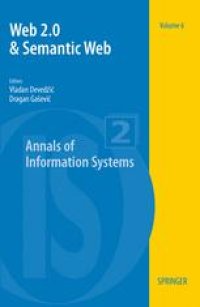
Ebook: Web 2.0 & Semantic Web
- Tags: Computer Systems Organization and Communication Networks, Information Systems and Communication Service, Information Systems Applications (incl.Internet), Business Information Systems
- Series: Annals of Information Systems 6
- Year: 2009
- Publisher: Springer US
- Edition: 1
- Language: English
- pdf
Web 2.0 describes the trend in Web technology and design that aims to enhance creativity, information sharing, and, especially, collaboration among users. Semantic Web refers to the intelligent interaction among systems and applications on the Web by deploying ontologies, semantic annotation of Web content, and reasoning. Its ultimate goal is to make data understandable to computers, and thus open to far greater utility and manipulation.
This special issue of AoIS presents cutting-edge research on both of these often opposed trends in computing and will support discussion on both the synergies and controversies inherent in the two technologies, while also considering what other technologies can contribute to both. Dramatic advances in service-oriented architectures, model-driven engineering, and Web mining technologies are but a few of the developments that might have a considerable impact on both Web 2.0 and Semantic Web, and they will all be covered in this volume.Web 2.0 describes the trend in Web technology and design that aims to enhance creativity, information sharing, and, especially, collaboration among users. Semantic Web refers to the intelligent interaction among systems and applications on the Web by deploying ontologies, semantic annotation of Web content, and reasoning. Its ultimate goal is to make data understandable to computers, and thus open to far greater utility and manipulation.
This special issue of AoIS presents cutting-edge research on both of these often opposed trends in computing and will support discussion on both the synergies and controversies inherent in the two technologies, while also considering what other technologies can contribute to both. Dramatic advances in service-oriented architectures, model-driven engineering, and Web mining technologies are but a few of the developments that might have a considerable impact on both Web 2.0 and Semantic Web, and they will all be covered in this volume.Web 2.0 describes the trend in Web technology and design that aims to enhance creativity, information sharing, and, especially, collaboration among users. Semantic Web refers to the intelligent interaction among systems and applications on the Web by deploying ontologies, semantic annotation of Web content, and reasoning. Its ultimate goal is to make data understandable to computers, and thus open to far greater utility and manipulation.
This special issue of AoIS presents cutting-edge research on both of these often opposed trends in computing and will support discussion on both the synergies and controversies inherent in the two technologies, while also considering what other technologies can contribute to both. Dramatic advances in service-oriented architectures, model-driven engineering, and Web mining technologies are but a few of the developments that might have a considerable impact on both Web 2.0 and Semantic Web, and they will all be covered in this volume.Content:
Front Matter....Pages i-xvi
Front Matter....Pages 1-1
TagFusion: A System for Integration and Leveraging of Collaborative Tags....Pages 3-23
Semantic Enhancement of Social Tagging Systems....Pages 25-54
Front Matter....Pages 56-56
Adaptation and Recommendation Techniques to Improve the Quality of Annotations and the Relevance of Resources in Web 2.0 and Semantic Web-Based Applications....Pages 57-77
Adaptive Reactive Rich Internet Applications....Pages 79-102
Front Matter....Pages 104-104
Towards Enhanced Usability of Natural Language Interfaces to Knowledge Bases....Pages 105-133
Semantic Document Model to Enhance Data and Knowledge Interoperability....Pages 135-160
Front Matter....Pages 162-162
Ontology-Based Data Mining in Digital Libraries....Pages 163-175
An Assessment System on the Semantic Web....Pages 177-200
Back Matter....Pages 201-201
Web 2.0 describes the trend in Web technology and design that aims to enhance creativity, information sharing, and, especially, collaboration among users. Semantic Web refers to the intelligent interaction among systems and applications on the Web by deploying ontologies, semantic annotation of Web content, and reasoning. Its ultimate goal is to make data understandable to computers, and thus open to far greater utility and manipulation.
This special issue of AoIS presents cutting-edge research on both of these often opposed trends in computing and will support discussion on both the synergies and controversies inherent in the two technologies, while also considering what other technologies can contribute to both. Dramatic advances in service-oriented architectures, model-driven engineering, and Web mining technologies are but a few of the developments that might have a considerable impact on both Web 2.0 and Semantic Web, and they will all be covered in this volume.Content:
Front Matter....Pages i-xvi
Front Matter....Pages 1-1
TagFusion: A System for Integration and Leveraging of Collaborative Tags....Pages 3-23
Semantic Enhancement of Social Tagging Systems....Pages 25-54
Front Matter....Pages 56-56
Adaptation and Recommendation Techniques to Improve the Quality of Annotations and the Relevance of Resources in Web 2.0 and Semantic Web-Based Applications....Pages 57-77
Adaptive Reactive Rich Internet Applications....Pages 79-102
Front Matter....Pages 104-104
Towards Enhanced Usability of Natural Language Interfaces to Knowledge Bases....Pages 105-133
Semantic Document Model to Enhance Data and Knowledge Interoperability....Pages 135-160
Front Matter....Pages 162-162
Ontology-Based Data Mining in Digital Libraries....Pages 163-175
An Assessment System on the Semantic Web....Pages 177-200
Back Matter....Pages 201-201
....